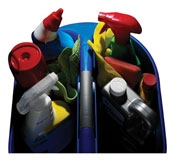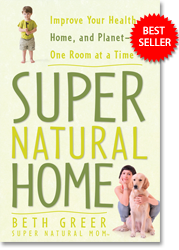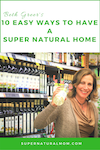 We assume they are safe. But in fact, many popular household cleaners are dangerously toxic. Learn about the eight scariest substances hiding under your kitchen sink, and how to replace them with safer, more natural options that really work.
We assume they are safe. But in fact, many popular household cleaners are dangerously toxic. Learn about the eight scariest substances hiding under your kitchen sink, and how to replace them with safer, more natural options that really work.
By Jessie Sholl for ExperienceLife.com / October 2011
When a pain in Beth Greer’s shoulder led her to a chiropractor nine years ago, she wasn’t that worried. After all, she led a healthy lifestyle: She watched her weight, meditated regularly, and ate mostly organic food. Greer’s chiropractor wasn’t worried either; he diagnosed her with a herniated disk. But after three sessions, not only was she not better, the pain was beginning to radiate down her arm and into her fingers.
An MRI revealed the true cause of Greer’s pain: a tennis-ball-size tumor in her chest. The good news was the mass was benign. Still, each of the three thoracic surgeons Greer saw strongly recommended she have it removed. One wanted to get at it by going in under her collarbone, one wanted to reach the mass through her armpit, and the third wanted to remove a rib to get the tumor from the back.
They all agreed on just one thing: The surgery was risky. Because the tumor was in such a nerve-packed place, there was a real possibility that removing it could cause Greer to lose feeling in her hand.
Greer opted out of the surgery, and instead focused on doing everything she could to support her body’s healing capacity. Curious by nature (she and her husband, Steven Seligman, owned the Learning Annex, a group of schools offering short-term classes on everything from relationships to real-estate), Greer decided to learn everything she could about her condition and discovered that tumors typically grow in response to irritation and inflammation. Eliminating environmental toxins that might be contributing to her tumor’s growth seemed like a practical first step.
First, she turned her attention to the conventional household cleaning products tucked away in her cabinets. “I’d look at a label and it would say ‘hazardous to humans and domestic animals,’” says Greer. “So why would anyone want to use that?”
She ultimately tossed her entire collection of toxic cleaning products and began making her own with ingredients like vinegar, baking soda and essential oil. She also swapped her commercial body-care products and makeup for nontoxic ones, and she cleaned up her already healthy diet by eating only whole, unprocessed foods — without any labels.
Nine months later, her tumor was gone. Completely. Although she can’t pin her results on any one environmental change, Greer’s confident that cutting down her exposure to toxins played a critical role — so much so that she’s made sharing that information with others a central part of her life.
Today, Greer consults professionally with others who want to detoxify their homes and offices. In 2002 she and Seligman sold the Learning Annex and she began writing about toxin-free living. The result is her book, Super Natural Home (Rodale Books, 2009).
During her research for the book, Greer was shocked to learn that there’s no federal regulation of chemicals in household products. Rebecca Sutton, PhD, a senior scientist at the Environmental Working Group (EWG), explains, “In terms of household cleaners, neither ingredients nor products must meet any sort of safety standard, nor is any testing data or notification required before bringing a product to market.”
The average household contains about 62 toxic chemicals, say environmental experts. We’re exposed to them routinely — from the phthalates in synthetic fragrances to the noxious fumes in oven cleaners. Ingredients in common household products have been linked to asthma, cancer, reproductive disorders, hormone disruption and neurotoxicity.
Manufacturers argue that in small amounts these toxic ingredients aren’t likely to be a problem, but when we’re exposed to them routinely, and in combinations that haven’t been studied, it’s impossible to accurately gauge the risks. While a few products cause immediate reactions from acute exposure (headaches from fumes, skin burns from accidental contact), different problems arise with repeated contact. Chronic exposure adds to the body’s “toxic burden” — the number of chemicals stored in its tissues at a given time.
This toxic body burden is EWG’s chief concern about household chemicals. Sutton explains: “Our concern is daily, weekly, chronic exposure over a lifetime. Maybe if you’re exposed to a chemical a handful of times it wouldn’t cause harm, but some chemicals build up enough or cause enough harm in your body over time that it triggers some kind of disease outcome. The concept [of body burden] is that pollution is not just in our air and in our water — it’s also in us.”
No one can avoid exposure to toxic chemicals altogether, but it is possible to reduce it significantly. In the following pages, Greer, Sutton and other experts weigh in on the worst toxic offenders commonly found in household cleaning products, and offer ways to swap them for healthier, safer options.
1. Phthalates
Found in: Many fragranced household products, such as air fresheners, dish soap, even toilet paper. Because of proprietary laws, companies don’t have to disclose what’s in their scents, so you won’t find phthalates on a label. If you see the word “fragrance” on a label, there’s a good chance phthalates are present.
Health Risks: Phthalates are known endocrine disruptors. Men with higher phthalate compounds in their blood had correspondingly reduced sperm counts, according to a 2003 study conducted by researchers from the Centers for Disease Control and Prevention and the Harvard School of Public Health. Although exposure to phthalates mainly occurs through inhalation, it can also happen through skin contact with scented soaps, which is a significant problem, warns Alicia Stanton, MD, coauthor of Hormone Harmony (Healthy Life Library, 2009). Unlike the digestive system, the skin has no safeguards against toxins. Absorbed chemicals go straight to organs.
Healthier Choice: When possible choose fragrance-free or all-natural organic products. Greer recommends bypassing aerosol or plug-in air fresheners and instead using essential oils or simply opening windows to freshen the air. Besides causing more serious effects like endocrine disruption, “Aerosol sprays and air fresheners can be migraine and asthma triggers,” she says. Also consider adding more plants to your home: They’re natural air detoxifiers.
2. Perchloroethylene or “PERC”
Found in: Dry-cleaning solutions, spot removers, and carpet and upholstery cleaners.
Health Risks: Perc is a neurotoxin, according to the chief scientist of environmental protection for the New York Attorney General’s office. And the EPA classifies perc as a “possible carcinogen” as well. People who live in residential buildings where dry cleaners are located have reported dizziness, loss of coordination and other symptoms. While the EPA has ordered a phase-out of perc machines in residential buildings by 2020, California is going even further and plans to eliminate all use of perc by 2023 because of its suspected health risks. The route of exposure is most often inhalation: that telltale smell on clothes when they return from the dry cleaner, or the fumes that linger after cleaning carpets.
Healthier Choice: Curtains, drapes and clothes that are labeled “dry clean only” can be taken instead to a “wet cleaner,” which uses water-based technology rather than chemical solvents. The EPA recently recognized liquid carbon dioxide (CO2) as an environmentally preferable alternative to more toxic dry-cleaning solvents. Ask your dry cleaner which method they use. For a safer spot remover, look for a nontoxic brand like Ecover at a natural market, or rub undiluted castile soap directly on stains before washing.
3. Triclosan
Found in: Most liquid dishwashing detergents and hand soaps labeled “antibacterial.”
Health Risks: Triclosan is an aggressive antibacterial agent that can promote the growth of drug-resistant bacteria. Explains Sutton: “The American Medical Association has found no evidence that these antimicrobials make us healthier or safer, and they’re particularly concerned because they don’t want us overusing antibacterial chemicals — that’s how microbes develop resistance, and not just to these [household antibacterials], but also to real antibiotics that we need.” Other studies have now found dangerous concentrations of triclosan in rivers and streams, where it is toxic to algae. The EPA is currently investigating whether triclosan may also disrupt endocrine (hormonal) function. It is a probable carcinogen. At press time, the agency was reviewing the safety of triclosan in consumer products.
Healthier Choice: Use simple detergents and soaps with short ingredient lists, and avoid antibacterial products with triclosan for home use. If you’re hooked on hand sanitizer, choose one that is alcohol-based and without triclosan.
4. Quarternary Ammonium Compounds, or “QUATS”
Found in: Fabric softener liquids and sheets, most household cleaners labeled “antibacterial.”
Health Risks: Quats are another type of antimicrobial, and thus pose the same problem as triclosan by helping breed antibiotic-resistant bacteria. They’re also a skin irritant; one 10-year study of contact dermatitis found quats to be one of the leading causes. According to Sutton, they’re also suspected as a culprit for respiratory disorders: “There’s evidence that even healthy people who are [exposed to quats] on a regular basis develop asthma as a result.”
Healthier Choice: You don’t really need fabric softener or dryer sheets to soften clothes or get rid of static: Simple vinegar works just as well. “Vinegar is the natural fabric softener of choice for many reasons,” explains Karyn Siegel-Maier in her book The Naturally Clean Home (Storey Publishing, 2008). “Not only is it nontoxic, it also removes soap residue in the rinse cycle and helps to prevent static cling in the dryer.” White vinegar is your best choice for general cleaning; other types can stain.
Alternatives to chemical disinfectants abound, including antibacterial, antifungal tea-tree oil. Mix a few drops of tea-tree oil and a tablespoon of vinegar with water in a spray bottle for a safe, germ killing, all-purpose cleaner. Add a couple of drops of lavender essential oil for scent.
5. 2-Butoxyethanol
Found in: Window, kitchen and multipurpose cleaners.
Health Risks: 2-butoxyethanol is the key ingredient in many window cleaners and gives them their characteristic sweet smell. It belongs in the category of “glycol ethers,” a set of powerful solvents that don’t mess around. Law does not require 2-butoxyethanol to be listed on a product’s label. According to the EPA’s Web site, in addition to causing sore throats when inhaled, at high levels glycol ethers can also contribute to narcosis, pulmonary edema, and severe liver and kidney damage. Although the EPA sets a standard on 2-butoxyethanol for workplace safety, Sutton warns, “If you’re cleaning at home in a confined area, like an unventilated bathroom, you can actually end up getting 2-butoxyethanol in the air at levels that are higher than workplace safety standards.”
Healthier Choice: Clean mirrors and windows with newspaper and diluted vinegar. For other kitchen tasks, stick to simple cleaning compounds like Bon Ami powder; it’s made from natural ingredients like ground feldspar and baking soda without the added bleach or fragrances found in most commercial cleansers. You can also make your own formulas with baking soda, vinegar and essential oils. See the “DIY Cleaners” sidebar for a list of clean concoctions.
6. Ammonia
Found in: Polishing agents for bathroom fixtures, sinks and jewelry; also in glass cleaner.
Health Risks: Because ammonia evaporates and doesn’t leave streaks, it’s another common ingredient in commercial window cleaners. That sparkle has a price. “Ammonia is a powerful irritant,” says Donna Kasuska, chemical engineer and president of ChemConscious, Inc., a risk-management consulting company. “It’s going to affect you right away. The people who will be really affected are those who have asthma, and elderly people with lung issues and breathing problems. It’s almost always inhaled. People who get a lot of ammonia exposure, like housekeepers, will often develop chronic bronchitis and asthma.” Ammonia can also create a poisonous gas if it’s mixed with bleach.
Healthier Choice: Vodka. “It will produce a reflective shine on any metal or mirrored surface,” explains Lori Dennis, author of Green Interior Design (Allsworth Press, 2010). And toothpaste makes an outstanding silver polish.
7. Chlorine
Found in: Scouring powders, toilet bowl cleaners, mildew removers, laundry whiteners, household tap water.
Health Risks: “With chlorine we have so many avenues of exposure,” says Kasuska. “You’re getting exposed through fumes and possibly through skin when you clean with it, but because it’s also in city water to get rid of bacteria, you’re also getting exposed when you take a shower or bath. The health risks from chlorine can be acute, and they can be chronic; it’s a respiratory irritant at an acute level. But the chronic effects are what people don’t realize: It may be a serious thyroid disrupter.”
Healthier Choice: For scrubbing, stick to Bon Ami or baking soda. Toilet bowls can be cleaned with vinegar, and vinegar or borax powder both work well for whitening clothes. So does the chlorine-free oxygen bleach powder made by Biokleen. To reduce your exposure to chlorine through tap water, install filters on your kitchen sink and in the shower.
8. Sodium Hydroxide
Found in: Oven cleaners and drain openers.
Health Risks: Otherwise known as lye, sodium hydroxide is extremely corrosive: If it touches your skin or gets in your eyes, it can cause severe burns. Routes of exposure are skin contact and inhalation. Inhaling sodium hydroxide can cause a sore throat that lasts for days.
Healthier Choice: You can clean the grimiest oven with baking-soda paste — it just takes a little more time and elbow grease (see recipes in “DIY Cleaners” sidebar). Unclog drains with a mechanical “snake” tool, or try this approach from the Green Living Ideas Web site: Pour a cup of baking soda and a cup of vinegar down the drain and plug it for 30 minutes. After the bubbles die down, run hot water down the drain to clear the debris.
Jessie Sholl has written about health for a variety of publications. She is also the author of Dirty Secret: A Daughter Comes Clean About Her Mother’s Compulsive Hoarding (Simon and Schuster/Gallery Books, 2010).


